
| 
|

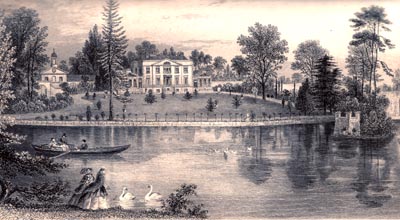 EPSOM AND EWELL WELLS - Chapter 1
EPSOM AND EWELL WELLS - Chapter 1The Waters of Ewell (up to 1700)
Dr Bruce E Osborne
Dr Bruce E Osborne
1.1. Bourne Hall Lake as it was in 1860 from Swete S J (1860) Hand-Book of Epsom.
Celtic, Roman and Medieval Ewell and Ewell springs.
Preamble - These first two chapters focus on the early origins of the spa healing movement in ancient Roman and later Italian Renaissance cultures. The impact of practices and beliefs is then traced to England with special reference to Epsom and Ewell and the building of Nonsuch Palace by Henry VIII. The hypothesis is that an early post-Renaissance bathing establishment, what we would later call a spa, was established at Ewell. Subsequently new ideas on the efficacy of mineralised waters, particularly drinking, led to the demise of the Tudor tradition and this in turn heralded the advent of spa healing as became established in the 17th century and later. The idea that Ewell was the focus of the Tudor Renaissance revival of the classical balnea in Britain places a new emphasis on the interpretation of the history of the village and its associated palace Nonsuch.
The early history of the exploitation of mineralised waters in the Epsom region and elsewhere is speculative. In the early seventeenth century the discovery of Epsom waters are the subject of folklore, which will be considered further in due course. Before 1600 however there was no apparent record of mineral water exploitation in the manner associated with the later era. This is not to say that exploitation did not take place. What happened was that early exploitation had significantly different characteristics to that of the spa era after 1600. It is therefore necessary to seek evidence on a broader front to understand how and why the waters were used before 1600.
In order to provide structure to any debate on the origins of Epsom mineral water exploitation there are three research areas, which potentially provide insights. The first of these is the development of bathing during the Roman occupation of Britain up to about 400 AD., an activity which integrated with the earlier Celtic beliefs and practices. Later during Saxon times it is apparent that the application of mineral waters degenerated into a localised practice based on custom and use of holy wells associated with saints. It is not until the late medieval period that new initiatives appear, providing the second area worthy of scrutiny. The third and final area justifying attention is the inspirational source for the post 1600 spas, upon which the great spas of England were created.
First it is necessary to consider the Roman practice of bathing and bathhouses up to 400 A.D. and any relevance that this may have to the Epsom region. Nearby Ashtead, adjacent to the Roman Stane Street, had a significant Roman Villa with a Bath House. This was located to the north of the present village and a mineralised spring, with Epsom Salts, existed in the immediate vicinity. The Bath building comprised a circular sudatorium or laconicum, 15-20 foot internal diameter. This would have been the original hot chamber, however later modifications suggest that two rooms were heated in its final form.[1] This establishment would have represented an essentially private bathing facility, but usage would have extended to slaves, servants and others associated with the Villa, in fact many of the local populace. Such a bathing facility was necessary for the Roman lifestyle to ensure relief from amongst other things, lead poisoning, from which they certainly suffered, albeit undiagnosed at the time. Are there indications of other spa facilities locally from the Roman era?
Hard evidence is not available. However it is possible to speculate, based on minimal evidence locally and from other spas such as Bath with the imaginative and sometimes fanciful writings of the Welsh chronicler Geoffrey of Monmouth. His 12th century account proposes that Bladud built Kaerbadus, now Bath. From this the later legend of Bladud was elaborated.[2] The debatable legendary beginnings are qualified by substantiated facts linked with the Roman development of Bath thermal waters. Aquae Sulis, the ancient designation for Bath, resulted from a merging of Celtic and Roman reverence for the hot springs. Roman mythology and celebration of waters integrated with the native culture of sacred wells giving the conjoint appointment, combining the Celtic deity Sul with the Latin term for waters. In the case of the adjacent temple the integration went further. Here the Roman Goddess Minerva becomes Sulis Minerva.[3] A similar argument can be applied to Buxton, known as Aquae Arnemetiae.
Celtic, Roman and Medieval Ewell and Ewell springs.
Preamble - These first two chapters focus on the early origins of the spa healing movement in ancient Roman and later Italian Renaissance cultures. The impact of practices and beliefs is then traced to England with special reference to Epsom and Ewell and the building of Nonsuch Palace by Henry VIII. The hypothesis is that an early post-Renaissance bathing establishment, what we would later call a spa, was established at Ewell. Subsequently new ideas on the efficacy of mineralised waters, particularly drinking, led to the demise of the Tudor tradition and this in turn heralded the advent of spa healing as became established in the 17th century and later. The idea that Ewell was the focus of the Tudor Renaissance revival of the classical balnea in Britain places a new emphasis on the interpretation of the history of the village and its associated palace Nonsuch.
The early history of the exploitation of mineralised waters in the Epsom region and elsewhere is speculative. In the early seventeenth century the discovery of Epsom waters are the subject of folklore, which will be considered further in due course. Before 1600 however there was no apparent record of mineral water exploitation in the manner associated with the later era. This is not to say that exploitation did not take place. What happened was that early exploitation had significantly different characteristics to that of the spa era after 1600. It is therefore necessary to seek evidence on a broader front to understand how and why the waters were used before 1600.
In order to provide structure to any debate on the origins of Epsom mineral water exploitation there are three research areas, which potentially provide insights. The first of these is the development of bathing during the Roman occupation of Britain up to about 400 AD., an activity which integrated with the earlier Celtic beliefs and practices. Later during Saxon times it is apparent that the application of mineral waters degenerated into a localised practice based on custom and use of holy wells associated with saints. It is not until the late medieval period that new initiatives appear, providing the second area worthy of scrutiny. The third and final area justifying attention is the inspirational source for the post 1600 spas, upon which the great spas of England were created.
First it is necessary to consider the Roman practice of bathing and bathhouses up to 400 A.D. and any relevance that this may have to the Epsom region. Nearby Ashtead, adjacent to the Roman Stane Street, had a significant Roman Villa with a Bath House. This was located to the north of the present village and a mineralised spring, with Epsom Salts, existed in the immediate vicinity. The Bath building comprised a circular sudatorium or laconicum, 15-20 foot internal diameter. This would have been the original hot chamber, however later modifications suggest that two rooms were heated in its final form.[1] This establishment would have represented an essentially private bathing facility, but usage would have extended to slaves, servants and others associated with the Villa, in fact many of the local populace. Such a bathing facility was necessary for the Roman lifestyle to ensure relief from amongst other things, lead poisoning, from which they certainly suffered, albeit undiagnosed at the time. Are there indications of other spa facilities locally from the Roman era?
Hard evidence is not available. However it is possible to speculate, based on minimal evidence locally and from other spas such as Bath with the imaginative and sometimes fanciful writings of the Welsh chronicler Geoffrey of Monmouth. His 12th century account proposes that Bladud built Kaerbadus, now Bath. From this the later legend of Bladud was elaborated.[2] The debatable legendary beginnings are qualified by substantiated facts linked with the Roman development of Bath thermal waters. Aquae Sulis, the ancient designation for Bath, resulted from a merging of Celtic and Roman reverence for the hot springs. Roman mythology and celebration of waters integrated with the native culture of sacred wells giving the conjoint appointment, combining the Celtic deity Sul with the Latin term for waters. In the case of the adjacent temple the integration went further. Here the Roman Goddess Minerva becomes Sulis Minerva.[3] A similar argument can be applied to Buxton, known as Aquae Arnemetiae.
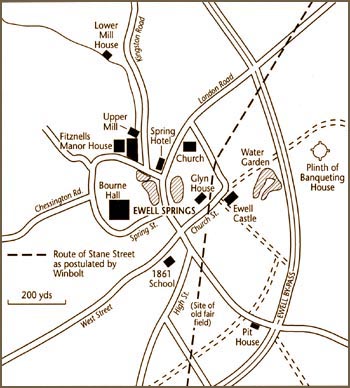
1.2. Map of Ewell showing the springs.
There is some weak evidence to suggest that this merging of Celtic and Roman water cultures also took place in Surrey. Prior to the re-emergence of healing by water in medieval times, the earliest celebrated local springs would have been at nearby Ewell. Epsom itself appears to have had no celebrated springs before c.1600 and until their discovery Ewell was the premier community.[4] Extensive Iron Age and Romano-British remains at Ewell, two miles north of Epsom, testify to the importance of the settlement.[5] In particular, during the restoration of the Bourne Hall lake and associated springs during the winter of 1996/7, local museum staff recovered considerable quantities of artifacts. These ranged from Iron Age, Roman and Saxon coins and brooches to a late Bronze Age axe head. Such finds testify to the longevity of Ewell and to the possible sacred worship or reverence of the springs as objects were cast into the waters as gestures to the gods.[6] Other discoveries elsewhere in the locality have included a Roman flue tile, perhaps from a furnace flue for a bathhouse.[7]
Archaeological evidence, found in 1847, proposes possibly eight Romano sacred wells or shafts in the locality of Pit House/Staneway House. Human cremated remains and carefully placed animal bones in the wells suggest a hallowed re-use of what may be old water sources, although the presence of an issue nearby questions the digging of wells up to 37 feet deep.[8] Rattue interprets such deposits as ritualistic. The well shaft was a symbolic gateway to the Underworld and rites had to be performed when the shaft was abandoned or abused.[9] Other finds include a 4 metre shaft adjacent to the Ewell by-pass dug by treasure hunters. Orton (1997) observes that wells or shafts of the Roman period are a regular feature in Ewell’s archaeology.[10] This is all suggestive that the settlement of Ewell, located on Stane Street, could have been a place of Roman bathing and related water activity. The nature of this celebration would have combined the more esoteric values of Celtic mythology with the Roman preoccupation with bathing for social and health reasons. It would have been a significantly different type of experience and practice to that associated with the much later spas of the 17th century and thereafter.
The preponderance of prolific springs, as well as the name Ewell itself, lends credence to this notion. Willis suggests that the spring(s) were an ancient Holy Well with belief in their healing powers going back to pagan times, with later dedication to St Catherine.[11] Medieval E(t)well[12], albeit a scribes error in Doomsday, and Awell provide etymological evidence of the importance of the wells. Other variants include "Eauuelle" (1066) and "Euuelle"(675).[13] The derivation can be traced from wielle/wylle (well) to aewiell and the present name. In fact Ewell is the oldest noted English place name containing an element of "well", being first recorded in 675.[14] Little evidence survives of these early periods and it is not until the middle of the second millennium that harder evidence is available.
Such evidence comes from Toland's Description of Epsom, (1711)[15], in which he proposes the location of a cold bath at Ewell "since, by reason of the spring, the water may not only be chang'd for every new comer, but a basin be likewise made adapted for swimming, which on such occasions was the practice of the antients."[16] One interpretation is that such practices dated back to ancient times in Ewell. In 1408 the spring was known as Cakeswell, by 1577 it was described as "one hut called Katteswell - the head of the river", this being corrupted to St Catherine's Well.[17] Another event that took place in Ewell was the creation of a stone built pond in the 1530s. This was the forerunner of the Bourne Hall pond of today. It is recorded in the Survey of Ewell 1577 as a Banqueting House and Pond built by one Saunders. Archaeological evidence indicates that it was built of reused architectural stone from Merton Abbey. This in turn suggests a relationship with the contemporaneous building of Nonsuch Palace nearby using the similar stone.[18] By Toland's time Ewell was therefore a place of ancient water traditions, likely including healing, but had also aspired to introduce later basic water based facilities, again for healing which was itself a more rudimentary practice than today, together with landscaping.
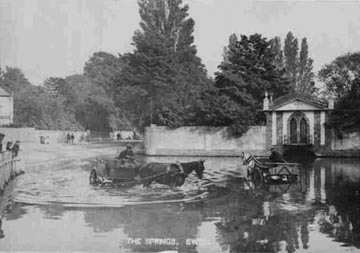 1.3. Ewell Spring c.1900.
1.3. Ewell Spring c.1900. At this juncture it is useful to appraise medieval care of the sick because it is from this background that the concept of the modern spa resort was to develop. It also gives clues as to the role of water in Ewell at that time. In medieval England, hospitals and almshouses were as common as monasteries. The hospitals were invariably administered by a religious order. They were often small localised institutions performing a variety of roles, which included physical care of the poor, infirm and sick, care for their spiritual needs, hospitality for travellers and education.[19] This multi-purpose role was to be echoed in later developments of health resorts, where spiritual well-being was an integral part of physical health, a theme traceable in the Roman approach to health and bathing. The role of water within the medieval hospitals was orientated to bathing, often with sophisticated plumbing. St John’s Hospital, Bath, had a bath house within its confines.[20] It was only later, as a broader appreciation of the value of water for healing was rediscovered that it became a major factor in the provision of health care. The exceptions to this were the leper colonies, usually located near a spring or a holy well. Such unfortunates were ostracised from society and the illness treated as a crime under the "De Leproso Amovendo". The church implemented such banishment through a panel of clergy who diagnosed the condition and then instituted a formalised exclusion.[21]
As early modern Ewell emerged from the medieval period, with its religious bias and primitive medicine interwoven in a superstitious potpourri, it is apparent that it was a local settlement of considerable importance, certainly it was larger than Epsom. However with the advent of Epsom Spa in the 17th century this position was challenged. Comparative data for 1664 gives a relationship of houses as: Ashtead 100 percent, Epsom 128 percent and Ewell 145 percent.[22]
Toland's desire to see bathing facilities at Ewell was realised in the form of the Dipping Place and marble bath. At the former remarkable cures were reported, including that of rheumatics by sitting in the water. According to tradition, Richard Bliss noted a marble bath in this pool when he came to Ewell in c.1786. It was described about this date as "the crystalline cool bath, which has justly been allowed to be one of the coldest in England, and from several instances of remarkable cures....it is lately become frequented by genteel people". The water was good for the eyes and a pint at bed time cured a cold.[23] The Dipping Place was eventually enclosed to commemorate victory at Waterloo and exists in this form today near the "Dog Gate". With the remodelling of the street in 1820 the adjacent Butchers Shop was removed. Before this the water from the Rectory Garden pool flowed over the road in a stream.
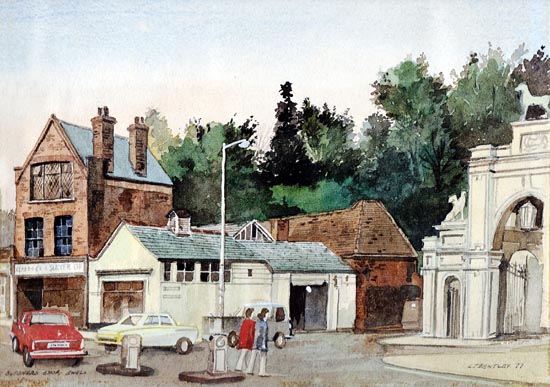
1.4. Ewell Dog Gate and modern day butchers shop, now removed, where once a stream flowed across the road. Watercolour by L J Bentley, 1977.(copyright B E Osborne)
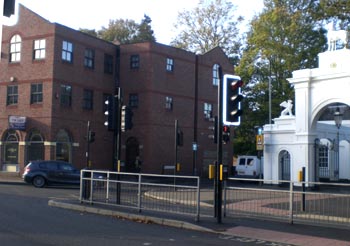 The same view as above in October 2011.
The same view as above in October 2011. The Dipping Place and the adjacent Long Spring were the focal point of the village in the 19th century and were traditionally used for more than just the application of water. Cloudesley Willis records an incident relayed by his father. A man who had lived in the cottage next door to Willis senior took his wife to the Long Spring. Here he tied her to the railings and offered her for sale. A deal was struck with another man for 18 pence and a pot of beer. Apparently the new couple lived together quite happily thereafter.[24]
A further piece of evidence concerning the efficacy of the Ewell springs comes in the description of a purging well in Ewell, noted by Dr John Macpherson in 1871.[25] Different Ewell waters appeared to have different medical qualities and not all these were necessarily the same waters referred to by Toland (1711). Sunderland (1915) also states that Ewell had a purging well.[26] The explanation for this is that Ewell enjoyed water sources emanating from both the chalk aquifer and the Tertiary strata. The latter would give magnesium salt impregnated water whereas the chalk water would have given the higher flows of the main Ewell springs.[27] Interestingly Toland saw Ewell as the more suitable location for the cold bath spa than Epsom, due to the greater volume of water available. This observation goes back to the earlier emphasis on bathing at Ewell, where either type of water could usefully be used; rather than drinking the waters, which was the general practice at Epsom Spa. This emphasis is to be significant in the development of Henry VIIIs aspirations for Ewell covered in the next chapter.
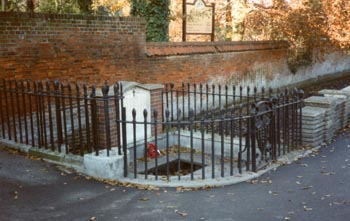
1.5. The Dipping Place, Ewell, 1997.
Summarising, in Celtic and Roman times it is arguably Ewell that was the focus of healing by mineral water, particularly through bathing, rather than Epsom. We can guess that this tradition would have prevailed, in a degenerated form, through Saxon times and the Norman conquest. In post medieval times there were new initiatives that brought Ewell springs back into prominence.
Click on website below to return to Index and Introduction.
Website: Click Here
SUPPLEMENTARY INFORMATION
1) TOPOGRAPHICAL LOCATION:
England
3) INFORMATION CATEGORY:
Springs and Wells General InterestHistory & Heritage


